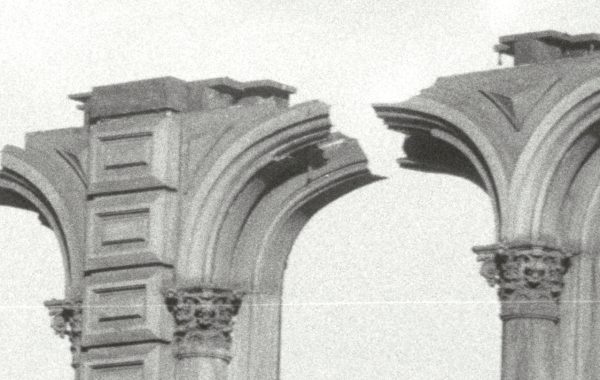The white stripes show the gaps between the now-removed lath:
Structural engineering is about structure, right? A while ago, while looking at a historic house upstate, we ran into a problem. The building had wood-stud bearing walls sheathed with clapboard and we ran into an obvious problem: the bearing walls were not performing properly. The studs were buckling, the walls were racking in-plane, and there were out-of-plane bulges in the walls.
The first problem is obvious when you see it: a 2×6 stud should be straight and instead it is curved, with the maximum out-of-line movement at the midnight between floors. Nearly all of the damaged studs were buckling parallel to the plane of the wall. This can be the result of overload, and that possibility is our immediate concern when we see it, or it could be warping of the wood from repeated asymmetric wetting and drying cycles, or it could be forced movement from one of the other two problems.
The second problem is when previously rectangular walls become parallelograms. The walls in wood-stud buildings act as shear walls, resisting lateral pressures (wind mostly, in the New York State). Racking is a sign that the walls are not doing that job properly. Racking often first manifests as diagonal cracking in the plaster, but in this projects that did not happen, for reasons explained below. Racking may not be noticeable to non-engineers until it gets quite severe; those of us who spend our time looking for building defects get used to seeing small out-of-vertical movements, while normal people (normal meaning non-engineers) do not.
The third problem is the one that occasionally sends building owners or tenants screaming for an engineer, as it consist of visible, out-of-plane bulging of the walls. This can be combined with the first problem, so that what you see is a series of studs at 16 spacing all curved the same way to create the bulge, but sometimes the bulging is only in the sheathing and the studs themselves are straight.
So far, I’ve been discussing wood-frame pathology, but the issue at hand was something more interesting concerning the distinction between structure and non-structure: the obvious feature of this building and the reason that the racking wasn’t obvious is that the interior plaster and lath had been removed. The exterior walls had been reduced to exterior sheathing and studs and the interior walls and been reduced to only studs.
Modern wood-frame houses used plywood, OSB, or some similar sheet product as sheathing on the exterior face of the exterior walls, and gypsum board as sheathing on the interior. These materials readily act as vertical diaphragms, allowing the walls to act as shear walls. Clapboard does not: the effectiveness of sheathing in enabling diaphragm action is related to the maximum spacing possible between fasteners in both the vertical and horizontal directions, and narrow planks have nails that have to be close together in one direction. A layer of diagonal sheathing can help, but most houses don’t have it.
Lath and plaster work nearly as well as modern sheet materials in connecting the individual studs. We don’t think of plaster, or quarter-inch wood lath, or the brads that connect lath to the studs as structural and they’re not very strong. But they are strong enough because the forces are distributed so widely: the plaster on one side of a room may be a continuous sheet 8 or 10 feet hight and 20 feet long. This reduces the forces on any one nail or any one strip of lath to manageable sizes. In other words, if you perform structural analysis on the elements of the plaster finish in a wood-frame house, they are strong enough to contribute significantly.
Even today, most wood-frame houses receive minimal structural design. In the nineteenth century, they received none. But we can use analysis today to demonstrate that the “non-structural” portions of the house are strong enough to contribute to the overall strength, and thus show that the damage that was found after the plaster was removed was caused by the removal.
Oops.




You must be logged in to post a comment.